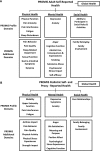Patient-Reported Outcomes in Glomerular Disease
- PMID: 27259977
- PMCID: PMC5220669
- DOI: 10.2215/CJN.13231215
Patient-Reported Outcomes in Glomerular Disease
Abstract
Incorporation of the patient perspective into research and clinical practice will enrich our understanding of the status and management of patients with glomerular disease and may result in therapies that better address patient needs. In recent years, the importance of the patient experience of glomerular disease has become clear, and significant efforts have been undertaken to systematically capture and describe the patient's disease experience. Patient-reported outcome instruments provide a means to assess the patient's experience in a quantitative manner, thus enabling for comparisons within and between patients. Patient-reported outcome assessments are solely on the basis of a patient report about the status of their health without amendment or interpretation by a clinician or others. Patient-reported outcome assessments provide an opportunity to incorporate the patient perspective into clinical care, research, and clinical trials. Our paper provides an overview of terminology and development methods for patient-reported outcomes and reviews (1) currently available patient-reported outcome instruments appropriate for use in glomerular disease, (2) existing patient-reported outcome data in glomerular disease, and (3) opportunities for incorporating patient-reported outcome instruments into clinical care and research.
Keywords: Disease Management; Humans; Patient Outcome Assessment; glomerulonephritis; glomerulopathy; kidney disease; patient-centered outcomes; quality of life.
Copyright © 2016 by the American Society of Nephrology.
Figures



References
-
- FDA: FDA Guidance for Industry Patient-Reported Outcome Measures: Use in Medical Product Development to Support Labeling Claims. Available at: http://www.fda.gov/downloads/Drugs/GuidanceComplianceRegulatoryInformati.... Accessed November 11, 2015 - PMC - PubMed
-
- Perrone RD, Coons SJ, Cavanaugh K, Finkelstein F, Meyer KB: Patient-reported outcomes in clinical trials of CKD-related therapies: Report of a symposium sponsored by the national kidney foundation and the U.S. Food and Drug Administration. Am J Kidney Dis 62: 1046–1057, 2013 - PubMed
-
- NCBI Bookshelf: BEST (Biomarkers, Endpoints, and Other Tools). Available at: http://www.ncbi.nlm.nih.gov/books/NBK338448/?report=reader. Accessed November 11, 2015
-
- PedsQL: The PedsQL Measurement Model for the Pediatric Quality of Life Inventory. Available at: http://www.pedsql.org/. Accessed November 11, 2015
-
- SF-36: 36-Item Short Form Survey from the RAND Medical Outcomes Study. Available at: http://www.rand.org/health/surveys_tools/mos/mos_core_36item.html. Accessed November 11, 2015
Publication types
MeSH terms
Grants and funding
LinkOut - more resources
Full Text Sources
Other Literature Sources
Medical

